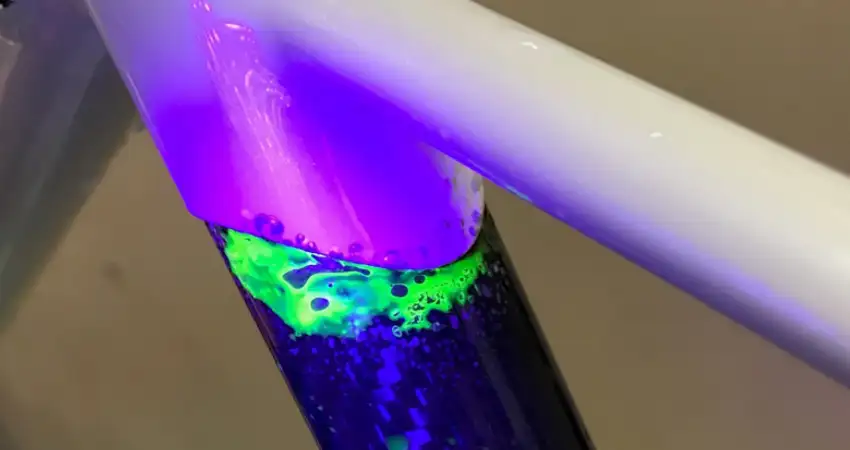Have you ever wondered if your carbon fiber frame is damaged? Perhaps you’ve noticed a few cracks or chips, or maybe you’re experiencing some unusual vibrations while riding. Whatever the case may be, it’s crucial to address any potential damage to your carbon fiber frame promptly.
In this article, we will explore the telltale signs of a damaged carbon fiber frame and provide you with tips on how to detect them. By knowing what to look for, you can ensure the longevity and safety of your bike. So, if you’ve ever asked yourself, “how to tell if a carbon fiber frame is damaged,” keep reading for valuable insights and actionable solutions.
How To Spot A Damaged Carbon Fiber Frame

Carbon fiber frames have become increasingly popular in the cycling world due to their lightweight, strength, and aesthetic appeal. However, just like any other material, carbon fiber frames are not immune to damage. Even the most durable carbon frames can develop cracks, chips, or other issues over time, compromising their structural integrity.
Visual Inspection
One of the easiest ways to identify damage on a carbon fiber frame is through a visual inspection. Here are some key things to look out for:
1. Visible cracks: Check the entire surface of the frame, paying close attention to areas such as the joints, bottom bracket, and seat tube. Look for any visible cracks, no matter how small they may be.
2. Delamination: Delamination occurs when the layers of carbon fiber separate from each other, creating a visible gap or bulge. Run your fingers along the frame to feel for any inconsistencies or lift the bike to see if there are any noticeable changes in shape.
3. Impact marks: If you’ve been involved in a crash or accidentally dropped your bike, inspect the frame for any signs of impact. Look for dents, scuffs, or scratches in the carbon fiber, as they can indicate damage beneath the surface.
4. Paint damage: While paint damage alone doesn’t necessarily mean the frame is compromised, it can be an indication of underlying damage. Examine the paint for any cracks, chips, or peeling, as they may be covering up underlying issues.
Sounds and Vibrations
Sometimes, damage to a carbon fiber frame may not be immediately visible, but you can still detect it through sounds and vibrations. Here’s what to listen and feel for:
1. Creaking or clicking noises: Unusual noises coming from your bike while riding can be a sign of a damaged frame. Pay attention to any creaking or clicking sounds, particularly when you’re applying force to the pedals or going over bumps.
2. Excessive vibrations: While it’s normal for bikes to vibrate to some extent, excessive vibrations can indicate a problem. If you notice increased vibrations that weren’t present before, it could be a sign of damage to the frame.
Performance and Handling
Damage to a carbon fiber frame can have a noticeable impact on the bike’s performance and handling. Look out for the following signs while riding:
1. Decreased stiffness: If your carbon frame feels flexy or lacks the usual stiffness, it may be compromised. Notice any changes in the responsiveness or rigidity of the frame when pedaling hard or turning corners.
2. Unstable or unpredictable handling: A damaged frame can affect your bike’s stability and handling. If you notice that your bike feels less predictable, has a tendency to wobble, or feels imbalanced, it could be a red flag.
Professional Inspection
While conducting your own inspections is crucial, it’s also recommended to have your carbon fiber frame professionally inspected by an experienced technician. They have the expertise and tools necessary to identify hidden or subtle damage that may not be apparent to the naked eye.
During a professional inspection, the technician may use techniques such as:
- Ultrasound testing: This non-destructive testing method allows technicians to determine if there are any hidden defects within the carbon fiber layers.
- X-rays: X-ray technology can reveal internal damage that’s not visible externally, such as cracks or fractures.
- Tap test: By tapping the frame and listening for distinct sounds, a technician can detect inconsistencies or delamination.
Remember, prevention is key. Regularly inspecting your carbon fiber frame and addressing any damage promptly can help prevent more significant problems down the line. If you suspect your frame is damaged, it’s best to consult a professional rather than risk your safety by continuing to ride.
Maintenance and Care Tips
To help prolong the life of your carbon fiber frame and minimize the risk of damage, here are some maintenance and care tips to follow:
Clean your frame regularly: Use a mild detergent and a soft cloth to clean your carbon fiber frame, avoiding abrasive cleaners or tools that may scratch the surface.
Avoid excessive torque: Make sure to tighten bolts and fasteners to the manufacturer’s specifications. Over-tightening can stress the carbon fiber and lead to damage.
Protect during transport/storage: When transporting or storing your bike, consider using frame protection, such as foam tubing or a bike bag, to prevent accidental impact.
Inspect after crashes or impacts: Even minor accidents can cause hidden damage. Always inspect your frame after a crash or significant impact, even if there are no visible signs of damage.
Frequently Asked Questions
1. What visual signs indicate a damaged carbon fiber frame?
A damaged carbon fiber frame may show cracks, chips, or dents on the surface. Look for discolored areas, exposed fibers, or paint peeling off, as these indicate potential damage.
2. How can I check for hidden damage in a carbon fiber frame?
Inspect the frame thoroughly by tapping it with a coin or small tool. Hollow sounds or vibrations may suggest internal damage. Also, carefully check areas where the frame joints or lugs are connected for any abnormalities.
3. Are there any indicators of damage during a ride?
While riding, if you experience sudden changes in stiffness or hear unusual creaking sounds from the frame, it could indicate structural damage. Also, keep an eye out for changes in the handling or alignment of the bike.
4. Should I be concerned about minor scratches or scuffs on the frame?
Minor cosmetic scratches or scuffs are usually not a cause for concern. However, deeper scratches that expose the fibers or compromise the structural integrity of the frame should be inspected more closely.
5. How often should I check for damage on my carbon fiber frame?
Regularly inspect your carbon fiber frame after rides, especially after a crash or impact. It is recommended to visually check for damage at least once a month, paying attention to high-stress areas and components.
Final Thoughts
In conclusion, determining if a carbon fiber frame is damaged is crucial to ensuring the safety and performance of your bike. By inspecting the frame for visible signs of cracks, delamination, or damage to the paint or clear coat, you can start identifying any potential issues.
Additionally, conducting a tap test by lightly tapping the frame with a coin or your knuckles can help detect hollow sounds indicative of internal damage. Lastly, taking your bike to a professional mechanic or carbon repair specialist for a thorough inspection is recommended, as they have the expertise to assess hidden damages and provide appropriate solutions. B
y following these guidelines, you can confidently identify if your carbon fiber frame is damaged and take necessary steps to maintain its integrity and safety.

